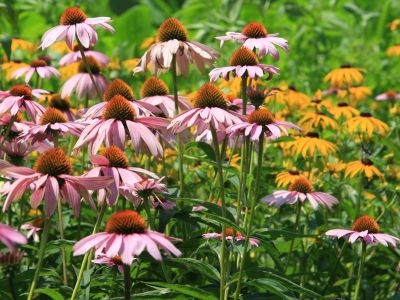Growing Summer Flowers in Kentucky Heat
A well-established flower bed or border can create a welcoming garden space. In addition to often needed curb appeal, a profusion of blooms will be quite attractive to pollinators and beneficial insects. While some flowers in Kentucky heat will wilt, others will thrive. To begin choosing flowering plants suited to Kentucky gardens, first consider the plant’s growth requirements and characteristics. Let’s take a closer look at several popular flower options.
Rudbeckia – In selecting flowers in hot summer regions, many choose wildflowers. Also known as black-eyed Susan, rudbeckia plants are abundant in Kentucky meadows and along roadsides. Though the wild versions of rudbeckia may not be ideal in formal plantings, several ornamental cultivars of rudbeckia exist, specifically, Rudbeckia hirta types. Popular varieties of rudbeckia include ‘Irish Eyes’ and ‘Sahara.’
Echinacea – Echinacea, or coneflowers, are commonly grown flowers for Kentucky summers. Especially attractive to pollinators, most cultivars bloom in various shades of purple. New varieties of this flower bloom in a range of colors like white, yellow, orange, and red. Echinacea plants can be purchased as transplants or grown from seed. Though economical to grow from seed, plants will not begin to bloom until the second growing season.
Portulaca – Portulaca plants are ideal flowers for Kentucky heat for use as a groundcover. Highly adaptable to a wide range of soil types, portulacas are particularly able to withstand heat and drought conditions. Traditionally used in xeriscaping, they do quite well when incorporated into flower beds or containers too.
Lantana – An immensely popular bedding plant, lantana plants will absolutely thrive in summer heat. Short plants produce several clusters of bloom per plant. Lantana plants are ideal for growers who wish to enjoy continuous color within the flower bed. These flowers are especially attractive to several types of butterflies.
Zinnia – A garden full of Kentucky summer flowers would not be complete without the inclusion of zinnias. Ranging in size depending upon cultivar, zinnias offer a profusion of color throughout the entire summer season. Zinnias also vary greatly in terms of color. Newly introduced varieties offer even more choices.
